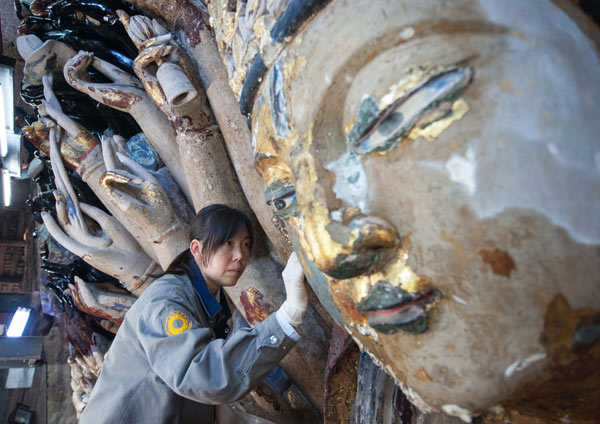Xi says protecting relics a priority
 0 Comment(s)
0 Comment(s) Print
Print E-mail China Daily, April 13, 2016
E-mail China Daily, April 13, 2016
China's top leadership has reiterated its staunch determination to intensify protection of the nation's cultural heritage.
 |
|
A cultural relic restoration specialitst checks the stone texture condition of a Guangin statue at the Dazu Rock Carvings site in Chongqing in March 2014. [Photo/Xinhua] |
Cultural relics and heritage impart the brilliance of China's civilization, culture and legacy, and they bond Chinese people together with the strong ethos they embody, President Xi Jinping said.
However, he said in a guideline statement released on Tuesday, the responsibility is great and the path will be long.
He put a priority on cultural relic protection and stressed the importance of perseverance in the protection work.
Premier Li Keqiang, meanwhile, emphasized that cultural relic protection is important because the traditional values that the relics embody continue to resonate in modern China, and they elevate social morals and boost social development.
Vice-Premier Liu Yandong, who presided over a national cultural heritage conference in Beijing on Tuesday, relayed Xi's and Li's emphasis on relic protection to conference participants.
Liu said the nation's cultural heritage work made great progress during the 12th Five-Year Plan (2011-15) period. For example, China now has 4,510 registered museums, an annual increase of about 300. Additionally, an average of 26,000 exhibitions were organized every year during that time, attracting more than 700 million visits every year.
About 140 billion yuan ($21.7 billion) in public funds was allocated to cultural heritage protection from 2011 to last year, according to the Ministry of Finance.
Nevertheless, problems still exist. About 44,000 cultural heritage sites disappeared during the late 1980s and 2011. Half of the counties in China do not have professional cultural relics protection administrations.
The vice-premier underlined the importance of improving the quality of Chinese museums and their exhibitions. She also noted that only 38 colleges in China have museum-related majors, and only seven have majors related to relic restoration.
Liu told the conference that non-government efforts to protect cultural heritage should be more actively sought.
Li Xiaojie, head of the China Cultural Relic Protection Foundation, said: "Social efforts should take the jobs that are currently difficult for governments to do. Governments can still offer guidance, but it is more efficient for the whole of society to gear up for the work."
For instance, the foundation, China's only State-level non-profit devoted to cultural relic protection, is planning a trial program in Zhejiang province to improve the restoration of privately owned property in traditional villages. Half of the capital will be provided by the foundation, with the rest to be raised by the property owners.
"Protection of cultural heritage doesn't have to conflict with urban construction," said Wang Wei, director of the Institute of Archaeology of the Chinese Academy of Social Sciences.
"Establishment of archaeological relic parks in recent years is an attempt to combine the two," Wang told the conference.
He added that Chinese professionals should more frequently go abroad to take part in international cooperation projects.
"While the US, Europe and Japan are active in such projects, China is often absent," he said.
"Some scattered projects are undertaken, but the country needs national-level strategic guidance to lead more expertise overseas to reflect our deserved status in the world as a culturally abundant ancient civilization."






Go to Forum >>0 Comment(s)